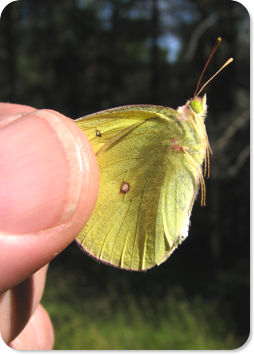 Butterflies are free . . . or are they?(Published in the Winnipeg Free Press, Feb. 17, 2001) Butterflies are free . . . or are they? What's got me onto butterflies in the middle of winter? Well, I don't normally read the "Wedding Show" supplement in the paper (not much guy-stuff), but a recent article was brought to my attention, and it's been bugging me ever since. It was about a local business that sells live butterflies for release at weddings. The idea was not new to me; this has become a real fad across North America in the last few years, and I guess it was inevitable that it would, unfortunately, reach us here in Winnipeg. Now, "What could possibly be wrong with setting free a bunch of beautiful butterflies to symbolize the purity of your love?" you ask. Well, I'll tell you, and it has nothing to do with being a grumpy, unromantic guy. It has to do with sound conservation practices and environmental ethics. Let me start by saying that I love butterflies, I've always loved butterflies, and I think that anything that gets people turned-on to butterflies can't be all bad. But I have some real concerns about this practice. There are disquieting connotations to the sale of live animals for human amusement, as well as the artificiality of "mail-order butterflies", but, ethics aside for the moment, there are some serious biological issues to be considered. Chief among these is releasing animals into an ecosystem where they may not belong. A Red Admiral on a Rough False Sunflower Proponents of butterfly-releases claim that by using native North American species they are doing no harm. Sometimes they go so far as to claim that they are "helping" nature and enhancing local populations. That's a load. This is not an environmentally beneficial practice. At it's best, it may be environmentally benign, as most of the released butterflies will end up as bird food or as splatters on car windshields or radiator grills. (How's that for a lasting symbol of your marriage?) When you bring in animals from other parts of North America (and, as far as I know, no one is breeding butterflies of local, Manitoba origin, in quantities to have any commercially available), you run the risk of introducing non-local genes and new diseases or parasites into the local population. And, like wraiths from Pandora's box, once released these can never be put back. The North American Butterfly Association, along with many other entomological societies and conservation agencies decry the practice of releasing captive- reared non-local butterflies, under any circumstances. To quote the president of the NABA, "There's no need to release butterflies -- they're already free." A Milbert's Tortoiseshell on a New England Aster And there is another more troubling aspect with the whole issue of "mail-order butterflies". It involves the sale of butterfly eggs and larvae for educational purposes. I'm deeply troubled by the message this sends to kids. Yes, it would be great to have kids witness the marvels of butterfly metamorphosis right in their class rooms, but we live in southern Manitoba. Unfortunately, most butterfly life cycles occur outside of the school year, in our brief summers. When we "force" nature out of season, when we bring it in from somewhere else, when we buy it online, we are messing with Mother Nature, and the lesson kids are left with is . . . that's OK. "Get what you want, whenever you want it and to heck with how it should happen in nature." That's a poor environmental ethic. If you really want to see butterflies out of season, then support the Assiniboine Park Conservatory's proposed Butterfly House project, where specimens will be dealt with in an environmentally sound manner, not released willy-nilly. But, better yet, get involved with butterfly gardening; set aside some land to grow the native plants that butterflies and their caterpillars need. If you want kids to relate to butterflies have them establish a butterfly garden on their school ground, where, in due course, female butterflies will come and lay their eggs. Sure, the life cycle will be completed outside of the school year and out of the class room, but the right lessons will be learned: care and respect for the nature that is all around us. Thanks for reading! Got to the: < Previous Column | What's Outdoors Front Page | Next Column >
|
||
|
For more on this topic, here's some articles in NatureNorth.com: Butterflies of Manitoba | Butterfly Gardening | Mourning Cloak Butterfly |
||
| You can help NatureNorth produce more great articles with a secure donation through PayPal. Our Google Adsense ads pay our server costs, but that's about it. To learn more follow this link: Support NatureNorth. Thank-you! | |
Return to the: NatureNorth.com Front Page
Or pick a seasonal issue to visit:
